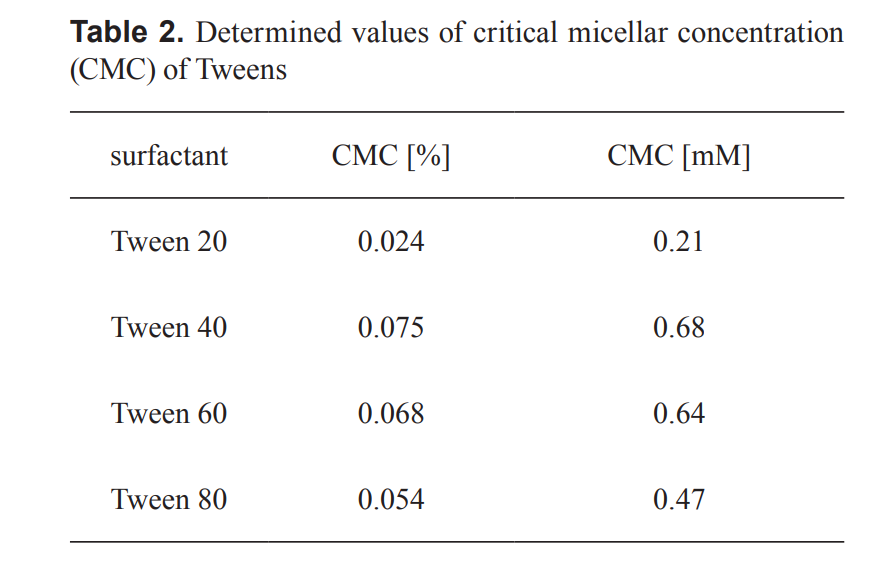Micellar-mediated extraction of green tea containing Chrysanthemum morifolium flowers
DOI:
https://doi.org/10.5604/01.3001.0010.7557Słowa kluczowe:
Micellar-mediated extraction, Chrysanthemum morifolium, non-ionic surfactantsAbstrakt
Micellar mediated extraction (MME) is a new and alternative method of obtaining biologically active substances, such as flavones, flavanones, anthocyanins, triterpene from plant material. In this study a series of polyethoxylated sorbitan esters of fatty acids (Tween 20, 40, 60 and 80) have been applied for the extraction of green tea containing Chrysanthemum morifolium flowers. Results showed that all tested surfactants were effective in the solubilisation of flavonoids and phenolic compounds. Probably, because of too high hydrophilicity, Tween 20 was not sufficient to obtain antioxidants, in contrast to another Tween. It has been shown that method is economical, attractive and ecological.
Statystyka pobrań
Bibliografia
B. K. Paul, S. P. Moulik, Curr. Sci. India, 2001, 80, 990–1001. Google Scholar
F. H. Quina, W. L. Hinze, Ind. Eng. Chem. Res., 1999, 38, 4150–4168. Google Scholar
K. Madej, Trends Anal. Chem., 2009, 28, 436–446. Google Scholar
K. Kiathevest, M. Goto, M. Sasaki, P. Pavasant, A. Shotipruk, Sep. Purif. Technol., 2009, 66, 111–117. Google Scholar
K. Robards, K., J. Chromatogr. A, 2003, 1000, 657–691 Google Scholar
K. Śliwa, A. Tomaszkiewicz-Potępa, E. Sikora, J. Ogonowski, Acta Bioch. Pol., 2013, 60, 803–806 Google Scholar
K. Śliwa, E. Sikora, J. Ogonowski, J. Oszmiański, J. Kolniak-Ostek, Acta Biochim. Pol., 2016, 63, 543–548. Google Scholar
M. Choi, K. Chan, H. Leung, C. Huie, J. Chromatogr. A, 2003, 983, 153–162 Google Scholar
A. Tomaszkiewicz-Potępa, K. Śliwa, P. Śliwa, Chem. Transactions, 2010, 1-Ch, 343–352 Google Scholar
M. Kabir, Colloids and Surfaces A, 2003, 216, 65–74. Google Scholar
W. Liu, W. J. Zhao, J. B. Chen, M. M. Yang, M.M., Anal. Chim. Acta, 2007, 605, 41–45. Google Scholar
US Pat., US 0037115A1, 2005. Google Scholar
GB Pat., GB 1502895, 1978. Google Scholar
US Pat., PCT US 9605560, 1996. Google Scholar
Y. Bingjia, Y. Li, H. Qiong, S. Akita, S., Chin. J. Chem. Eng., 2007, 15, 468–473. Google Scholar
Z. Shi, X. Zhu, H. Zhang, H., J. Pharm. Biomed. Anal., 2007, 44, 867–873. Google Scholar
N. Pourreza, S. Elhami, S., J. Iran. Chem. Soc., 2009, 6, 784–788. Google Scholar
HU Pat., HU 20093, 1994. Google Scholar
K. Tsuji-Naito, H. Saeki, M. Hamano, Food Chem., 2009, 116, 854–859. Google Scholar
M. Ukiya, T. Akihisa, K. Yasukawa, Y. Kasahara, Y. Kimura, K. Koike, T. Nikaido, M. Takido. J. Agric. Food Chem., 2001, 49, 3187–3197. Google Scholar
Y-Y. Xie, J-L. Qu, Qi-L. Wang, Y. Wang, M. Yoshikawa, D. Yuan, J. Agric. Food Chem., 2012, 60, 12574–12583. Google Scholar
M. T. Yasuda, K. Fujita, T. Hosoya, S. Imai, K. Shimoi, J. Agric. Food Chem., 2015, 63, 7693–7699. Google Scholar
M. S. Hussain, S. Fareed, M. Ali, M. A. Rahman, J. Nat Pharm., 2012, 3, 4646. Google Scholar
W. Grajek, Przeciwutleniacze w żywności. Aspekty zdrowotne, technologiczne, molekularne i analityczne, WNT, Warszawa, 2007, pp 325-368. Google Scholar
M. Cybul, R. Nowak, Herba Polonica, 2008, 54, 68–78. 26. G. Shabir, F. Anwar, B. Sultana, Z. M. Khalid, M. Afzal, Q. M. Khan, M. Ashrafuzzaman, Molecules, 2011, 16, 7302–7319. Google Scholar
R. Perez-Roses, E. Risco, R. Vila, P. Penalver, S. Canigueral, J. Pharm. Pharmacol., 2015, 67, 666–672. Google Scholar
D. F. Cortes-Rojas, C. R. F. Souza, W. P. Oliveira, Sep. Sci. Techn., 2015, 50, 207–213. Google Scholar

Pobrania
Opublikowane
Jak cytować
Numer
Dział
Licencja
Prawa autorskie (c) 2017 Państwowa Wyższa Szkoła Zawodowa w Tarnowie & Autorzy

Utwór dostępny jest na licencji Creative Commons Uznanie autorstwa – Użycie niekomercyjne 4.0 Międzynarodowe.



